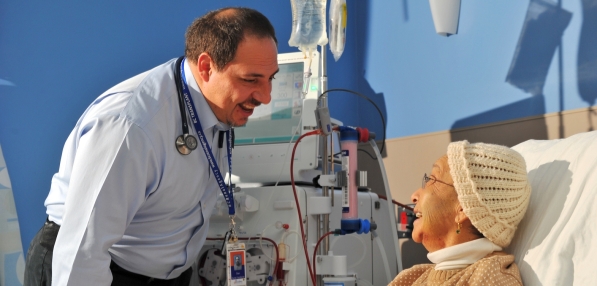Increasing safety and quality of care, while minimizing risk
What if you could increase your patient’s safety and quality of care, while minimizing risk? This is exactly what the Clinical & Systems Transformation (CST) project aims to achieve.
It’s a no-brainer for Leanne Heppell, Vice President of Patient Safety & Innovation and Chief of Professional Practice & Nursing with PHC. Heppell has been working in healthcare since she graduated nursing school in 1982 and is thrilled that this work is finally becoming a reality.
“It’s a once-in-a-lifetime opportunity for us to really do a good job of creating evidence-informed standards of care across the board, which will ultimately improve patient care,” says Leanne. “The added benefit is this relationship-building amongst the three Health Organizations.”
Prior to this project, PHC and VCH worked on standardizing practices for patient care, but Leanne says it was often difficult to reach consensus. CST enables staff to come together with a common vision and agree on leading practices – developing trust through collaboration.
“Whenever you bring people together with that kind of knowledge and they agree on the right way to care for a patient, automatically that’s going to improve the quality of care we give.”
She adds that having those leading practices enabled by technology will automatically reduce risk, compared to using a paper system.
“The ability to use technology is going to help us flag patients at risk, ensure we give the right drug or treatment to the right patient at the right time, and it will have built-in checks and balances to help reduce adverse events,” says Leanne.
As a patient representative for the project, Debbie Nider shares Leanne’s excitement about our ability to provide better patient care. Debbie sits on CST’s Project Steering Committee and ensures the patient perspective is considered.
“From time to time, the public hears about a patient death due to incorrect medications being given. With this new system, the risk of this happening will diminish,” says Debbie.
Having a more complete health record is expected to prevent duplication of information and tests, streamline record-keeping and provide easier access to the information healthcare staff need.
“I look forward to hearing how streamlined the system is, making it easier for medical personnel to spend more time with patients and less time trying to decipher and collate information about their patient,” says Debbie.
“This is a historic undertaking in the BC health industry and we are lucky to be among the first to test drive it.”
Background information
• CST is a joint initiative of VCH, PHSA and PHC, and one of the largest and most complex healthcare projects in Canada. It spans across several areas of the continuum of care, including: acute care inpatient and outpatient units and ambulatory care. As well as creating consistent, leading practices, and a shared clinical information system, CST will deliver HIMSS Level 5 functionality.
• Clinical design teams, made up of hundreds of highly-skilled, multi-disciplinary professionals from across the three Health Organizations and Team IBM (experts from IBM Technical Services, Deloitte, Leidos Solution Builders and the University of Pittsburgh Medical Centre), started work on April 7, 2014. These teams are tasked with designing our future workflows, based on leading practices. In doing so, they are defining the requirements for our new clinical information system.
For more information, please contact Donna Stanton, CST Executive Director/Transformation Lead, VCH at donna.stanton@vch.ca. You’re also invited to submit suggestions for future articles. If you have questions or feedback, please email info@CSTproject.ca.

